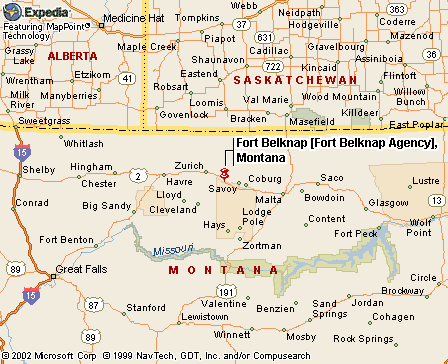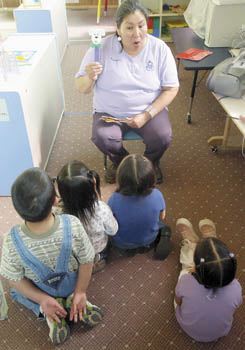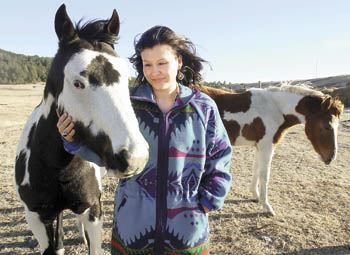|
|
Canku Ota |
|
|
(Many Paths) |
||
|
An Online Newsletter Celebrating Native America |
||
|
April 20, 2002 - Issue 59 |
||
|
|
||
|
Revitalizing Native Tongues |
||
|
by Karen Ivanova
Great FallsTribune Regional
Editor
|
||
|
credits:Tribune
photos by Mark Sterkel, Picture One-Pauline Standing Rock, Picture
Two-Lynette Chandler
|
|
Selena Ditmar was a freshman in 1942 when government workers arrived at her high school on the Fort Belknap Indian Reservation to pass out war ration stamps. Many of the elderly who came for tickets to buy sugar, lard and other scarce items spoke only Assiniboine. Confounded, the workers asked around the school for someone who could translate. "Because everyone was ashamed, nobody wanted to admit they spoke the language," recalls Ditmar, a 74-year-old retired nurse who sweeps her salt-and-pepper hair into an elegant bun. Though she finally came forward, she admits she, too, was reluctant to speak in front of the strangers. Decades later, Ditmar is stepping forward again -- this time with pride -- in a desperate attempt to teach her language before it's too late. Barely a century after missionaries and teachers at government boarding schools rapped Indian children's knuckles for speaking their native tongue, all 11 of Montana's Indian languages are in moderate to imminent danger of extinction. Afraid their identity will die with the languages of their prayers -- Piegan, Cree, White Clay, Nakoda -- Montana tribes are in step with a national movement to rescue their traditional voices, this time with the blessing of the U.S. government. From Salish speakers on the Flathead Reservation to the Sioux of Fort Peck, they're enlisting the memories of tribal elders and the power of digital computer technology to introduce Indian children to their native tongue. "Now there's a hunger for it on all reservations," said Moses Spear Chief, Piegan language coordinator for the Browning Public School District on the Blackfeet Reservation. "They want it so bad. The young adults want to know it because they didn't get a chance to speak it when they were younger and they want their kids to speak it, too. "If it's gone then their culture is gone ... Without the language, values are lost, your sense of belonging is gone." Speakers vanishing Fort Belknap's other language, Gros Ventre, or "White Clay," slipped to roughly a dozen speakers when 81-year-old Madeline Colliflower, a respected elder, died two years ago. Only three or four them are truly fluent, says 94-year-old Theresa Walker Lamebull. One survey identified only five Kootenai speakers on the Flathead Reservation. Some 500 to 600 Blackfeet speak the Piegan language fluently. Darrell Robes Kipp is a founder of the Nizipuhwahsin language immersion school on the Blackfeet Reservation, where 32 students, grades K-8, are learning reading, writing and arithmetic in Piegan. But even he has surges of doubt about whether the language can survive. "In my private moments I'm never sure," he says, quickly adding, "We'll pull it off, but I'll tell you, it's really tough." Even a language with 500 speakers is a whisper. "They say it takes 100,000 to make a language stable," said Luahiwa Namahoe, spokeswoman for Hawaii's "Aha Punana Leo" language immersion schools. The schools, on which the Browning program is modeled, have pulled Hawaii's language back from the brink: In 1983, fewer than 30 children younger than 18 were native speakers. Tribes from across the United States have visited Hawaii to learn more about the program. "We're now up to about 10,000 (speakers)," Namahoe said. "We're not out of the woods yet." Funding scaled back "It was a milestone in terms of turning around a longstanding philosophy direction in public education," Kipp said. But the younger Bush signed a reauthorization of federal education programs in January, dubbed "No Child Left Behind," that dramatically cuts funding for native language programs in public schools. Under the current federal program, Montana received $3 million in K-12, bilingual education funding this school year. Roughly $2 million of the funding paid for classroom instruction in K-12 schools. That funded native language education on reservations and English as a Second Language training elsewhere in the state. The rest paid for native language teacher training programs. Under the new funding formula, Montana is projected to receive $500,000 for all programs. "It will amount to a huge reduction in what we've seen for bilingual programs for Native American students," said Joyce Silverthorne, head of the Tribal Education Department on the Flathead Reservation and a member of the Montana Board of Public Education. Old scars remain From an 1887 report by the Commissioner of Indian Affairs, J.D.C. Atkins: "In the difference of language today lies two-thirds of our trouble ... Schools should be established, which children should be required to attend; their barbarous dialects should be blotted out and the English language substituted." James Crawford, a Washington-based writer and expert on language and education policy, presented the quote in a paper at the annual conference of the American Educational Research Association in 1994. Missionaries and the U.S. government established the schools, and the languages were forbidden. By the turn of the century, at least 80 percent of Indian children living on reservations were sent to such schools, estimates Wayne Stein, director of the Center for Native American Studies at Montana State University-Bozeman. The government schools began closing after Franklin Roosevelt took office in 1933. 'Everything's gone' "They used to punish us if they caught us talking our language at the mission," said Walker Lamebull, who still lives a block from the old stone mission church at Fort Belknap and just five miles from the teepee where she was born. "They used to make us kneel in the corner for a couple hours ... I learned a lesson." Walker Lamebull, whose Indian name is "Kills at Night," speaks her native tongue once a week to a handful of other elders at the Hays-Lodgepole senior center on the remote, southern edge of the reservation. She lives alone with her dog, "Nuisance." "That's the only companion I've got," Walker Lamebull says of the shaggy creature with a Benji face. "She don't talk," she adds, unleashing a peal of contagious laughter. Though Walker Lamebull's daughter lives next door, loneliness still haunts her creased face sometimes. "If I had somebody to talk to ...," she said. "Sometimes I talk to myself. If somebody heard me talking they might think I was going nuts." Through the college's "Speaking White Clay," project, 33-year-old student Terry Brockie visits Walker Lamebull at least once a week to speak. After five years of practice with Walker Lamebull and other elders, Brockie is conversational in White Clay and teaches at the Fort Belknap College. "I'm not a fluent speaker by any means, he said. "But I have a good understanding of it." Still, Walker Lamebull is frustrated by what she can't pass on, by her fading memory of her people's traditional stories. "Kids always want me to tell them old stories, but I forgot," said Walker Lamebull whose kitchen counter, with a Jesus statuette and Virgin Mary nightlight, recall her mission upbringing. "It makes me feel bad forgetting the old-time stuff I should have kept up." She shakes her head in wonder at the lost stories and her dwindling circle of elderly speakers. "Everything's just gone," she said. "Just vanished." Generation gap "He did not hurt me. But I was tapped on the cheek with a book for speaking my language and made to sit down," she said. "I remember it so vividly. I even remember the book it was. It was a geography book." Ditmar continued to speak Assiniboine at home until her grandparents died in the 50s, when her three daughters were young. "We never noticed at that time that we began to use the English language more as they passed away," she said. Though her oldest daughter understands Assiniboine, she does not speak it. As the voices of their parents and grandparents quieted, younger generations also felt the pressure of mainstream culture. As an ambitious young man growing up in the 50s on the Northern Cheyenne Reservation, Richard Littlebear saw that English was the language of everyone in positions of influence -- the teachers, the white ranchers who came into town, the local merchant. He earned an English degree and, until 1980, was adamantly opposed to teaching Indian children their language. That year the Tongue River Boy's School, where Littlebear was an administrator, won a bilingual education grant. Littlebear didn't want the job, but the college knew he was fluent and his administrative position was axed. Over the next few years, Littlebear says he had an "epiphany." "We're probably the last generation that, unless we do something, can converse deeply in spiritual and psychological terms and gain satisfaction from that," he said. Programs popular Sponsored by a four-year grant from the W.K. Kellogg Foundation, the institute helps tribal colleges and communities on all seven Montana reservations develop language classroom curriculums, teacher workshops, summer camps, mentoring programs and other activities. Summer language immersion camps on the Blackfeet Reservation attract an average of 250 participants. On the Crow Reservation young students are paired with fluent tribal elders through a mentor program. Montana State University joined the language preservation effort last fall. With a $1.6 million project through the U.S. Commerce Department, the university is installing high-end digital equipment at four Montana reservations: Northern Cheyenne, Crow, Rocky Boy's and Fort Belknap. Tribal members will be able to use the equipment at schools, senior centers and field museums to record stories and songs, take digital photos of beadwork or research their languages for a class project. A generation passes The late James Turning Bear, an elder from the Fort Peck Reservation, inspired the program six years ago, Driscoll said. She met him in a computer lab at Fort Peck Community College while she was helping the school hook up to the Internet. "I turned around and there was this older gentleman in the back and he's staring and he has these long braids," Driscoll said. Driscoll gave him a quick explanation of the Internet. But "he's not too enthused," she said. "He has his arms crossed." So she asked him what his interests were and he answered "Red Cloud." Driscoll typed the name into a search engine and pulled up a picture of the Lakota warrior and statesman from the Smithsonian. "He was a believer at that point," she said. For 50 years Turning Bear had combed libraries for information on his people, recording information in 19 large notebooks. He also had a collection of photographs, early tribal rolls and other historic documents. Turning Bear spent two weeks in a dormitory on MSU's Bozeman campus, archiving his material at the Burns Center. He also created his own Web site, doing much of the technical work himself. He died in 1999 at 74. "It shows what this generation has in their heads and their hearts and if we don't do this it's not going to be there anymore," Driscoll said. Pre-schools, computers In a lab at the Stone Child Community College on the Rocky Boy's Reservation, technicians use "Authorware 6" software to create computerized Cree lessons. The project was funded through a three-year, $374,000 grant from the Administration for Native Americans/Language Preservation project. In a counting lesson under development, a yellow baby duck floats across the computer screen. "Pe-yahk" says a woman's voice -- "one" in Cree. "Si-sip," she says, enunciating the word for "duck." A second duck floats in and a third and she counts up to 20. "The possibilities of Authorware 6 are tremendous," said Jolene Murie Crebs, language preservation coordinator at Stone Child College. "The sky is the limit with this program." Other lessons feature children's voices talking about Chief Rocky Boy. Young parents are embracing the cause. Next fall, the Rocky Boy's Head Start program will begin teaching Cree to expectant moms so they can teach the language to their babies. Craving their heritage When Shondlyn wants a drink of water, she must ask in Nakoda or White Clay. As a young girl, Chandler, whose Indian name is "Bi-dah-tha," or "Dancing Woman," was steeped in traditional culture. Her grandfather, Charles Long Fox, a Nakoda, made sure his grandchildren attended the tribe's ceremonies. "Every time I'd walk by the kitchen table he'd be beading and making quill work," Chandler said. Summers were spent on the road to powwows across the Northwest or camping in a log cabin with her grandmother, the "White Clay" traditionalist Florence Stiffarm. On an unseasonably warm winter day, she points out log poles marking the family graves on a windy hilltop above the one-room cabin where her grandmother raised nine kids. A graduate student in Native American Studies at Montana State University-Bozeman, Chandler is project coordinator for the Speaking White Clay Program at the Fort Belknap College. Her husband, an accomplished artist, is on the Native American studies faculty at the college. Universities and tribal colleges are at the heart of the language revitalization movement, Chandler said. The linguistic revival is one way young tribal scholars are taking their culture back from white anthropologists, researching and interpreting their language through their own eyes. Chandler has recorded 101 CDs of Walker Lamebull and other elders speaking White Clay. "It helps Indian people in Indian country start making decisions for themselves," she said. Words that heal Kipp, the Nizipuhwahsin founder, also sees language as a means of empowerment. "I'm seeing a strong resurgence amongst Native American people to recoup some of the nice things they were forced to give up," Kipp said. "We want to start a new conversation ... you're going to see a whole emergence of new Native American images." It will be an image of self-sufficiency and self-reliance, said Kipp, who boasts that not a single government nickel built the Nizipuhwahsin school. The movement isn't about shunning mainstream society and returning to old ways, he said. "I don't think any Blackfeet are going to give up the thermostat in their house or their four-wheel-drive truck and go jump on a horse and live in a teepee on the prairie." It's about recovering the cultural values that live in the mountain and prairie languages -- Piegan, Nakoda, Dakota, White Clay, Cree, Salish, Kootanai, Chippewa, Crow, Northern Cheyenne. The Piegan language is rich with kinship terms that glue families and communities together, Kipp said. One calls any woman their mother's age "aunt," he notes. "When we lost our language we lost our strong family bond and community bond," Kipp said. "It was what protected us in the severest of times." New beginnings A fluent Cree speaker, Standing Rock, 48, grew up on the Red Pheasant Reserve in Saskatchewan, where elders warned her not to forget her native tongue. "They say if you lose your language, you're going to lose your identity," Standing Rock said. "You're going to lose the value system, the belief system and if you try to pray to the higher power it's not as effective as it's supposed to be because God gave you a language to use." A mother of nine, Standing Rock regrets that her own children aren't fluent. "My kids are talking English more than Cree and it really, really makes me feel bad," she said. "They said, 'It's Mom and Dad's fault because you didn't speak Cree to us all the time.' And I guess, in a way, they're right." Standing Rock's 20-year-old son, "Anthony," decided to master the language after a recent trip to the reserve where his mother grew up. "I never knew kids up there talked that good," he said. "It's just like I speak English how they were talking." Listening, he felt a lump in his throat. "It kind of touched me," he said. "... I didn't want to cry because I'm a big man. I didn't want to show my tears, I just kept it in." Anthony insists his mother speak only Cree to him. She also speaks her first language to her 10-year-old son, Terry, even on shopping trips to Havre. The nearest town to the mountainous reservation, Havre is a mostly white community. "My little boy was aware of that. 'Mom, shhh,' he said. 'Don't talk loud. Don't talk Cree Mom, people are staring at me.' "I said, 'Son, you're not supposed to be ashamed of your language.'" |

|
www.expedia.com |
|
|
||
|
|
||
| Canku Ota is a free Newsletter celebrating Native America, its traditions and accomplishments . We do not provide subscriber or visitor names to anyone. Some articles presented in Canku Ota may contain copyright material. We have received appropriate permissions for republishing any articles. Material appearing here is distributed without profit or monetary gain to those who have expressed an interest. This is in accordance with Title 17 U.S.C. Section 107. | ||
|
Canku Ota is a copyright © 2000, 2001, 2002, 2003 of Vicki Lockard and Paul Barry. |
||
 |
 |
|
|
The "Canku Ota - A Newsletter Celebrating Native America" web site and its design is the |
||
|
Copyright © 1999, 2000, 2001, 2002, 2003 of Paul C. Barry. |
||
|
All Rights Reserved. |
||
 The
ancient languages of Montana's tribes are remembered by only a dwindling
number of elders. But a new urgency to save them has emerged, and
an unlikely marriage of tradition and modern technology may be the
answer.
The
ancient languages of Montana's tribes are remembered by only a dwindling
number of elders. But a new urgency to save them has emerged, and
an unlikely marriage of tradition and modern technology may be the
answer. Theresa
Walker Lamebull was caught only once speaking "White Clay"
at the mission school in Fort Belknap.
Theresa
Walker Lamebull was caught only once speaking "White Clay"
at the mission school in Fort Belknap.